南开大学 2014 年考博英语真题
Section A
Directions: Read the following four passages. Answer the questions below each
passage by choosing A, B,C or D. Mark your answers on the ANSWER SHEET. (40 points,
2 points each)
Passage One
I recently conducted a survey to see what people thought and knew about Martin Luther
King, Jr. I did this by bringing up the subject of MLK Day in casual conversations
with people and gauging their reaction. (The sampling was 23 friends, colleagues,
and strangers; 10 Black, 9 White, 3 Hispanic,
1 Asian; 4 were between the ages 42 -35 and 19 were 34 -20. ) All knew King as
the famous black civil rights leader who was killed, but few knew much more. The
majority of people under 30— regardless of race—knew little more, in fact. How
is it that Jill (black, 27, college educated) did not know that MLK was a Nobel
Peace Prize recipient? Or that Tim (white, 31,college educated) was clueless about
King’s nonviolent approach to civil rights activism?
Darlene (black, 23) thought she should have the day off to sleep in. She had no
idea the MLK day is really about doing something to inspire others.
What is the point of having a day to mark the man if we do not understand the
significance of his life? How is it that not only one of the greatest Americans,
but one of the most influential humans in the history of our planet is not better
known in this country? Had King been a football player or a musician, he may have
registered better with the present generation. Martin Luther King, Jr. was more
than just an inspirational black leader. His desire and ability to rise above his
own failings and those of fellow humans uplifted us all—both those who were living
at the time and those who have come after. Even if we do not know it, our world
is a better place because of his light.
Dr. King’s life was extinguished more than 30 years ago, but not his light. It
is still here for each of us to carry, and to illuminate even brighter with our
own unique creativity and contributions. Martin Luther King, Jr. was bom on January
15,1929 in Atlanta, Georgia. After graduating from Morehouse College and becoming
a minister, he made his way to Montgomery, Alabama in 1954. This was an important
decision for it was in the same city that, on December 1 of the following year,
Rosa Parks refused to give up her bus seat to a white man. King was elected president
of the Montgomery Improvement Association and led a boycott of Montgomery buses
throughout 1956, which brought him national recognition.
�
King’s legacy of non-violent activism was influenced by the teachings of Jesus
and Gandhi. King reinforced and expanded his Biblical convictions during a visit
to India in 1959, where he studied Gandhi’s methods of non-violent protests during
the early 1960’s.
A gifted orator, King ignited the world and a generation in the cause for American
civil rights with his “I Have a Dream” speech on Aug 28 1963 to a crowd of 250
000 in Washington, D. C. “We must forever conduct our struggle on the high plane
of dignity and discipline. We must not allow our creative protests to degenerate
into physical violence. Again and again we must rise to the majestic heights of
meeting physical force with soul force” ...“I have a dream that one day this nation
will rise up and live out the true meaning of its creed: We hold these truths to
be self-evident: that all men are created equal. ’’ ...“When we let freedom ring,
when we let it ring from every village and every hamlet, from every state and every
city, we will be able to speed up that day when all of God’s children, black men
and white men, Jews and Gentiles, Protestants and Catholics, will be able to join
hands and sing in the words of the old Negro spiritual, ‘ Free at last! Free at
last! Thank God Almighty, we are free at last!,”
Dr. King received the Nobel Peace Prize and was named Time magazine’s u Person
of the Year” in 1964. In his Nobel Prize acceptance speech, he said, “ Non-violence
is the answer to the crucial political and moral questions of our time: the need
for man to overcome oppression and violence without resorting to oppression and
violence. Man must evolve for all human conflicts a method which rejects revenge,
aggression and retaliation. The foundation of such a method is love. ’’ King was
one of the most extraordinary humans to ever grace our planet. He was a man who
met
hate and hopeless with love and inspiration. He used non-violence to point out the
obscenity of violence. Martin Luther King was gunned down at the Lorraine Motel
in Memphis on April 4, 1968. Some call it irony. I choose to think of it as his
final lesson to us.
1. The Purpose of the author in writing the passage is to .
A. condemn the terrorist action of Martin Luther King, Jr.,s assassination
B. honor Martin Luther King, Jr. since MLK Day is drawing near
C. criticize the present generations for their ignorance of Dr. King
D. highlight the significance of the beliefs and spirit of Dr. King
�
2. “Had King been a football player or a musician, he may have registered better
with the present generation. ’’ (Para. 4) can be best interpreted as “ ”.
A. King is not remembered by the present generation as a football player or a musician
B. The present generation is ignorant of King who gave his life for the peoples
of the world
C. If King had turned to music or sports he would have been more successful
D. It is meaningless to have a day to mark King since he is not famous enough
3. According to Dr. King, what is the solution to major political and moral problems?
A. Non-violence. B. Armed struggle. C. Violent activism. D. Believing in God.
4. Which of the following statements about Martin Luther King, Jr. is true?
A. His Nobel Prize acceptance speech was the famous “I Have a Dream” speech.
B. He was the first one who adopted a non-violent approach in political struggle.
C. He had a firm belief in God, which helped to form his non-violent activism.
D. He was named 4< Person of the Year” because of his w I Have a Dreamv speech.
5. The overall tone of the article can be best summarized as .
A. emotional B. furious C. indifferent D. matter-of-fact
Passage Two
A few decades ago, it was still possible to leave home and go somewhere else: the
architecture was different, the landscape was different, the language, lifestyle,
dress, and values were different. That was a time when we could speak of cultural
diversity. But with economic globalization, diversity is fast disappearing. The
goal of the global economy is that all countries should be homogenized. When global
hotel chains advertise to tourists that all their rooms in every city of the world
are identical, they don’t mention that the cities are becoming identical too: cars,
noise, smog, corporate high-rises, violence, fast food, McDonalds, Nikes, Levis,
Barbie Dolls, American TV and film. What,s the point of leaving home?
There are many causes for this dreary turn of events, but one is central: economic
globalization and institutions like the World Bank and the WTO promote a specific
�
kind of homogenizing development that frees the largest corporations in the world
to invest and operate in every market, everywhere. For these agencies and
corporation, diversity is not a primary value: efficiency is. Diversity is an enemy
because it requires differentiated sales appeal. What corporations love is creating
the same values,the same tastes, using the same advertising, selling the same
products, and driving out small local competitors. Mass marketers prefer
homogenized consumers. They also prefer places with low wages, cheap resources,
and the least restrictive environmental and labor laws. The new rules of global
trade are primarily set by the ultra-secretive World Trade Organization (WTO), which
now rivals the International Monetary Fund (IMF) as the most powerful, yet
undemocratic body in the world. Its rules are specifically designed to serve global
corporate expansion and the homogenization process. They make it nearly impossible
for nation-states to prevent certain harmful forms of corporate development, no
matter what problems they bring. So we find that European bankers can dominate Third
World economies ; Asian companies can cut down Canadian and Brazilian forests ;
American corporations can dominate the whole world’s farmers and food supply ;
Disney can homogenize consciousness and McDonalds can homogenize tastes, globally.
Every country loses while global corporations win.
Corporate invasions into diverse cultures often occur over vigorous protests by
local governments and populations that try to protect local business, culture,
health, food safety, and local livelihoods. Not everyone wants to become like
everyone else. ( More than one million of India’s small farmers protested against
the entry of industrial agriculture, specifically Cargill Corporation and Kentucky
Fried Chicken. ) Millions of others have protested against the invasion and
promotion of genetically engineered foods which are destroying local livelihoods
and threatening public health. But when
countries try to slow down these corporate invasions—or create laws that protect
local resources, or jobs, or health standards 一 they may find the laws challenged
at the WTO as illegal restrictions against foreign investment. In fact, a recently
proposed addition to the WTO would make it nearly impossible for any country to
prevent imports of biotech food products — despite public concern over health
aspects. Meanwhile, all places are starting to merge. In rural France, local cheese
farms are sucked up by giant agribusiness. In England, small towns in the countryside
have high-speed freeways and trucks jamming through them despite mass opposition.
Rice paddies in Bali are turned into hotel resorts. Small farms in Japan become
executive golf courses. Small businesses and retail shops everywhere, including
the U. S. , are being driven under by untaxed e-commerce, which the WTO may soon
codify. Nepalese villages have Sylvester Stallone on their billboards, Barbie in
their stores, and Jay Leno on their TV sets.
Every place is becoming everyplace else: monoculture. “Get there before it’s
�
ruined. ” Is this a familiar phrase? Is this a system you want?
If globalization homogenizes cultures, its effect on Nature is just as bad. With
every country pressured to open up its forests, minerals, water, and land to global
corporations, the few pristine places are disappearing fast. So are the native
people who live in them. So are the animals, plants and biota …the biodiversity
of the planet. ( Brazil, for example, recently suspended its environmental laws,
so that Amazon forests can be cut down faster to help the country pay off IMF debts.)
Meanwhile, industrial forestry practices, like clear-cutting, produce landscapes
so barren that it’s hard to know if it’s the Amazon or Oregon ; landscapes of
tree stumps look alike wherever they are. This is monoculture too. Biodiversity
is disappearing as fast as cultural diversity. Here’s the rationale for all this:
By serving the needs of global business, everyone benefits. “A rising tide lifts
all boats. ’’ Is this true? While CEO salaries for global corporations are rising
—some make $ 50 - 500 million annually—worldwide, real wages for most people are
falling. According to the U. N. , the gaps between rich and poor within countries
and among countries, has grown because of the inequities of global trade. Even in
the U. S. , the median wage of factory workers has fallen by 10% in the last two
decades. And, England now advertises that its workers are the lowest paid in Europe.
Low wages are suddenly virtuous. Apparently, the rising tide lifts mainly yachts.
The global economy is designed to benefit the largest corporations in the world,
who are getting rapidly larger and more dominant. Already some corporations are
bigger in economic terms than most nation states. Mitsubishi is the 22nd largest
economy in the world. General Motors is 26th. Ford is 31st. They are larger than
Denmark, Thailand, Turkey, Norway, Greece, Chile, Brazil, New Zealand and dozens
of others. What can we do? Dozens of good organizations are working on these issues.
This year, most are focused on the World Trade Organization Ministerial Meeting
in Seattle, Washington, two weeks from now. Most groups are demanding a halt to
all WTO expansion and a full public reassessment of its activities.
6. From the first paragraph,we know that .
A. the author is describing both the good and bad impacts of economic globalization
B. globalization is reducing the differences between the rich and the poor
C. the author is unhappy with the consequences of globalization
D. globalization is good for both the rich and the poor
7. The main purpose of the author in writing this passage is .
A. to discuss what’s good and what’s bad in economic globalization
�
B. to blame the WTO and other large global corporations for their wrongdoings
C. to justify his worries about the disappearance of cultural diversity
D. to refute the rationale of globalization and show his objection to global
monoculture
8. According to the passage, which of the following is NOT true about a homogenized
world?
A. Every place will become exactly the same as every place else.
B. Cultural diversity and biodiversity will not be ruined.
C. People’s value orientation is sure to be identical gradually.
D. People can buy the same goods and may have the same tastes.
9. Who should be blamed for the Brazilian forests,being down?
A. The International Monetary fund.
B. The World Trade Organization.
C. Large global corporations such as Mitsubishi.
D. The Brazilian government.
10. We can infer from the passage that vigorous protests occurred in India because
•
A. the Indians didn’t like the rules of the World Trade Organization
B. global corporations promoted the sale of genetically engineered foods there
C. the international corporations have destroyed the local people’s livelihood
and health
D. the Indians didn’t want to follow the new rules of global trade
Passage Three
Unless you lived through the Eisenhower era, it may be hard to imagine the impact
�
of the on- screen sight of sneering high-school students challenging adults with
switch-blades. But in 1950s America, killing was still seen as something rare and
horrible, something done by soldiers in battle, by lawmen, by gangsters, or by the
occasional psychopath. Homicides in movies, even those considered violent, were
infrequent. Those films presented juvenile delinquency more as the thread of
rebellion and disobedience than of outright violence.
The idea of American teenagers as killers was beyond compression. The change in
1957 when a wave of teen-street-gang killing in New York City (22 in the first six
months of the year) spurred the emergency deployment of six hundred Police Academy
cadets in a war on teen street crime. Though teen violence soon lost its place in
news headlines to other crises, it did not go away.
Thirty-five years later America is in the grip of a violence epidemic that has
transformed the country into one of the most dangerous nations on earth. The national
homicide rate, corrected for population growth, increased almost exactly 100
percent from 1950 to 1990. In major cities the increase has been much higher. In
Los Angeles County the 1953 homicide total was 82. In 1992, with a population almost
doubled, the total was 2, 512 一 an increase of over 1, 000 percent. These are
staggering increase by any measure, with the one-year toll for L. A. County exceeding
the deaths in over fifteen years of conflict in Northern Ireland. Youth crime
accounts for a disproportionate number of these killings. That’s more than twice
the number recorded a decade earlier, reflecting the fact, according to FBI reports,
that the number of youths who committed murder with guns was up 79 percent in one
decade. Clearly something has gone horribly wrong. In looking for a root cause,
one of the most obvious differences in the social and cultural fabric between
post-World War II and pre-World War II America is the massive and pervasive exposure
of American youth to television. Since the 1950s, behavioral scientists and medical
researchers have been examining screen violence as a possible causative element
in America’s spiraling violent crime rate. There is compelling evidence of a direct,
demonstrable
among
African-American youth. In 1992 the US surgeon general cited violence as the leading
cause of injury to women aged 15 to 44, and the US Centers for Disease Control
consider violence a public health issue, to be treated as an epidemic.
Homicide
leading
has
become
link.
the
second
cause
11. From the passage we can infer that .
A. from the 1950s on high-school students have been a threat to the safety of adults
B. in the 1950s only some gun-men used gun as weapons
C. it was in the late 1950s that violence was frequent
D. youth crime began in the 1950s
�
12. Which of the following is not true?
A. There were more than 22 killings of teenagers in New York, in 1957.
B. The wave of teen murder urged policemen to take a quick action.
C. Violence was so emergent that even six hundred students of Police Academy were
turned to for help.
D. Six hundred students of Police Academy were involved in the street crime.
13. A major reason for youth crime increase is .
A. population grows too much
B. young people are exposed too much to screen violence
C. violence is a public issue
D. the economic background
14. It is a fact, in 1992, that .
A. population in Los Angeles was of 2, 512 people
B. homicide totaled 352 in Los Angeles
C. homicide rose up to 2, 512 in Los Angeles
D. population in Los Angeles was over 1, 512
15. The word “spiraling”(Para.5) is close in meaning to .
A. moving B. changing C. rising D. falling
Passage Four
My mother raised me as best as she could, taking on odd jobs in the neighborhood
for money. Still without a father to tell me how to act and what was expected of
me, I felt lost. I wandered for years and got involved with tough guys on the East
Side of New York. They would fight madly over a
dropped coin. They would steal to get what they wanted. I wanted to be like them.
�
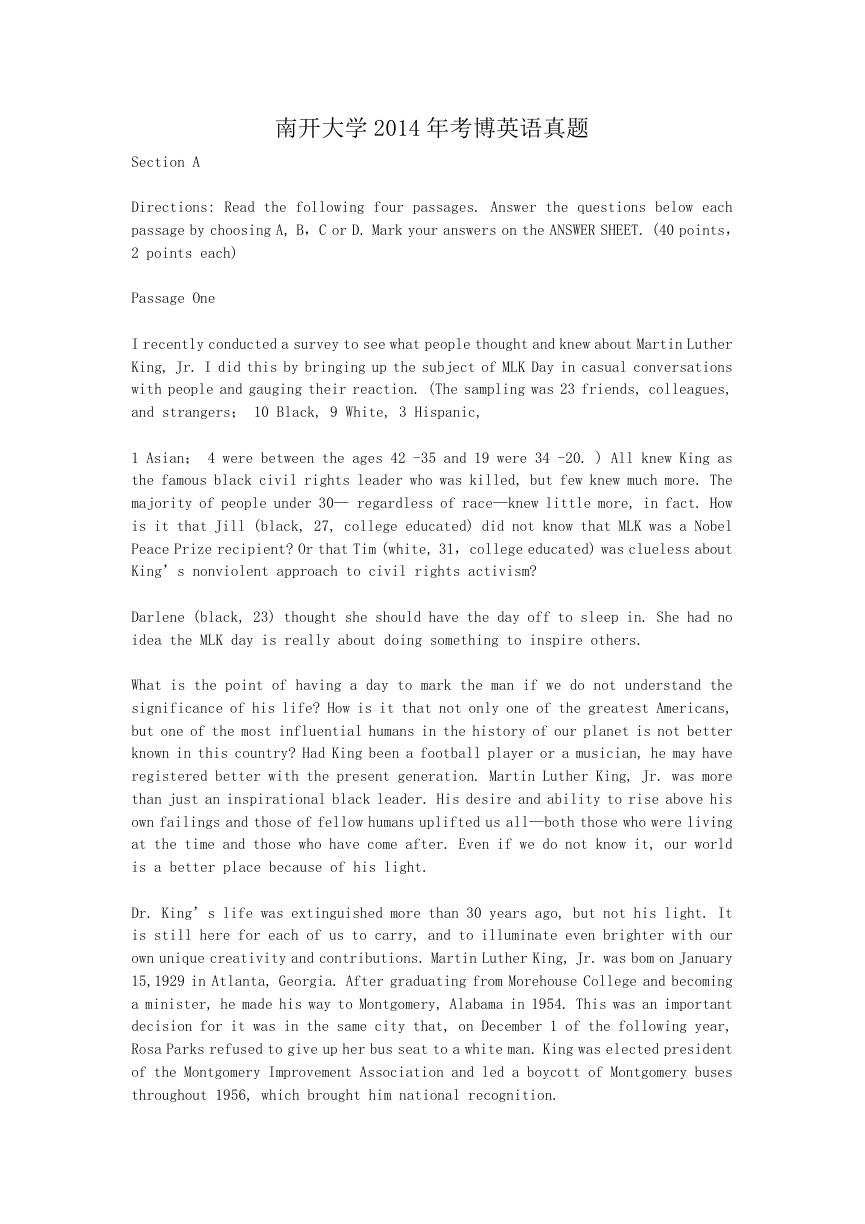


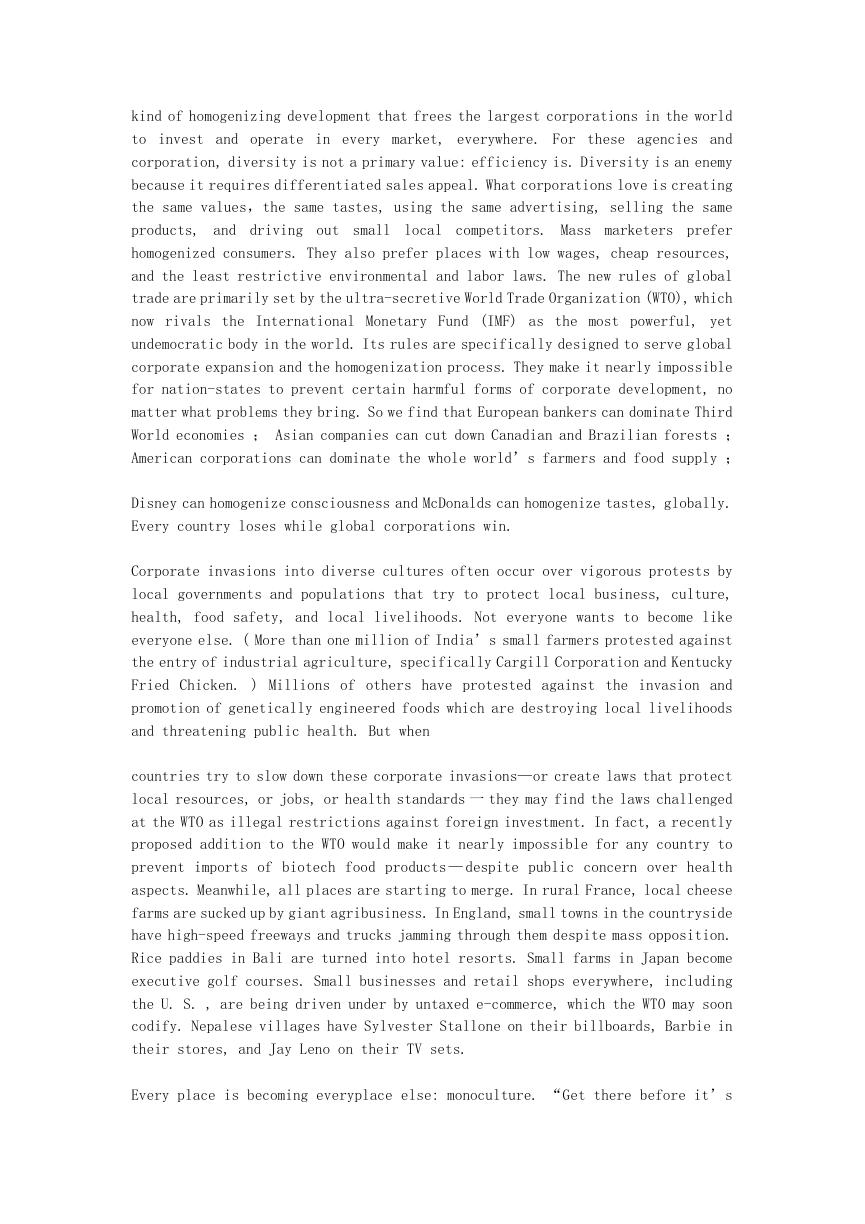
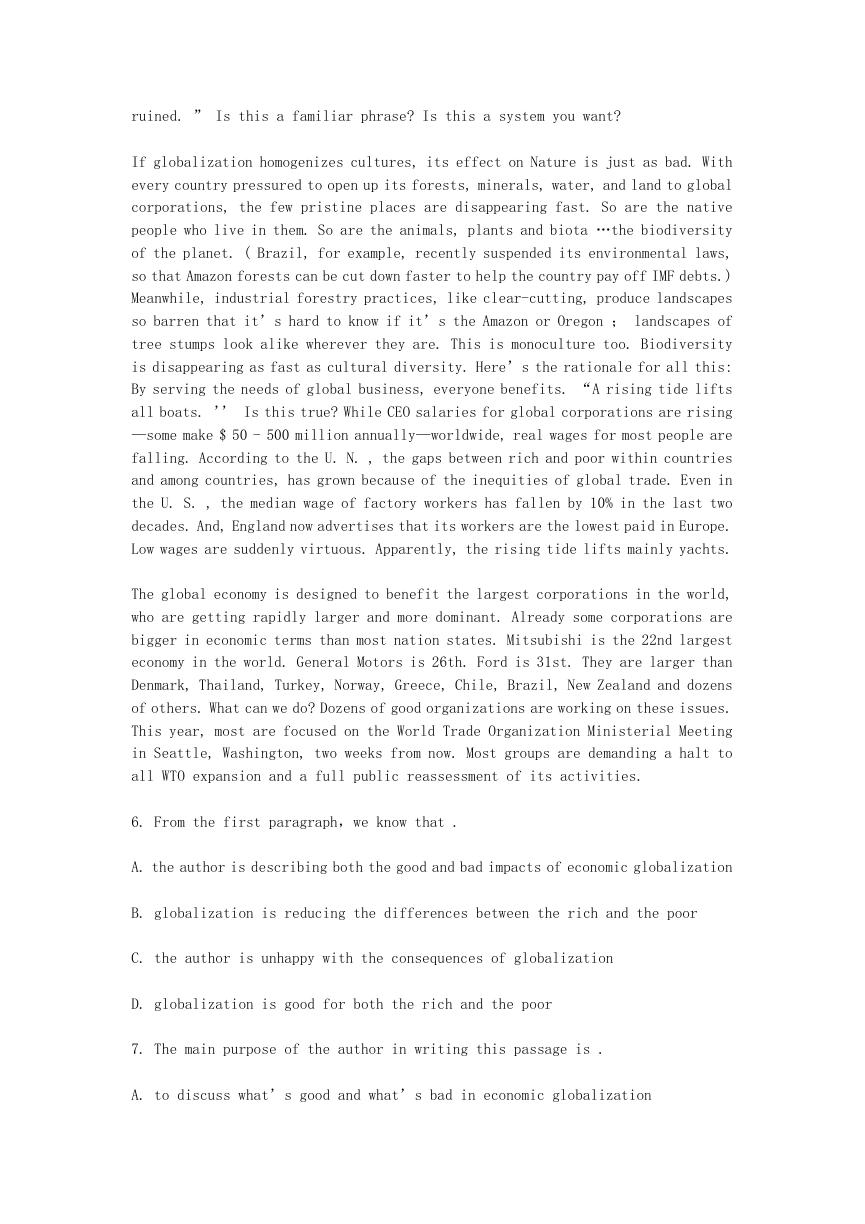
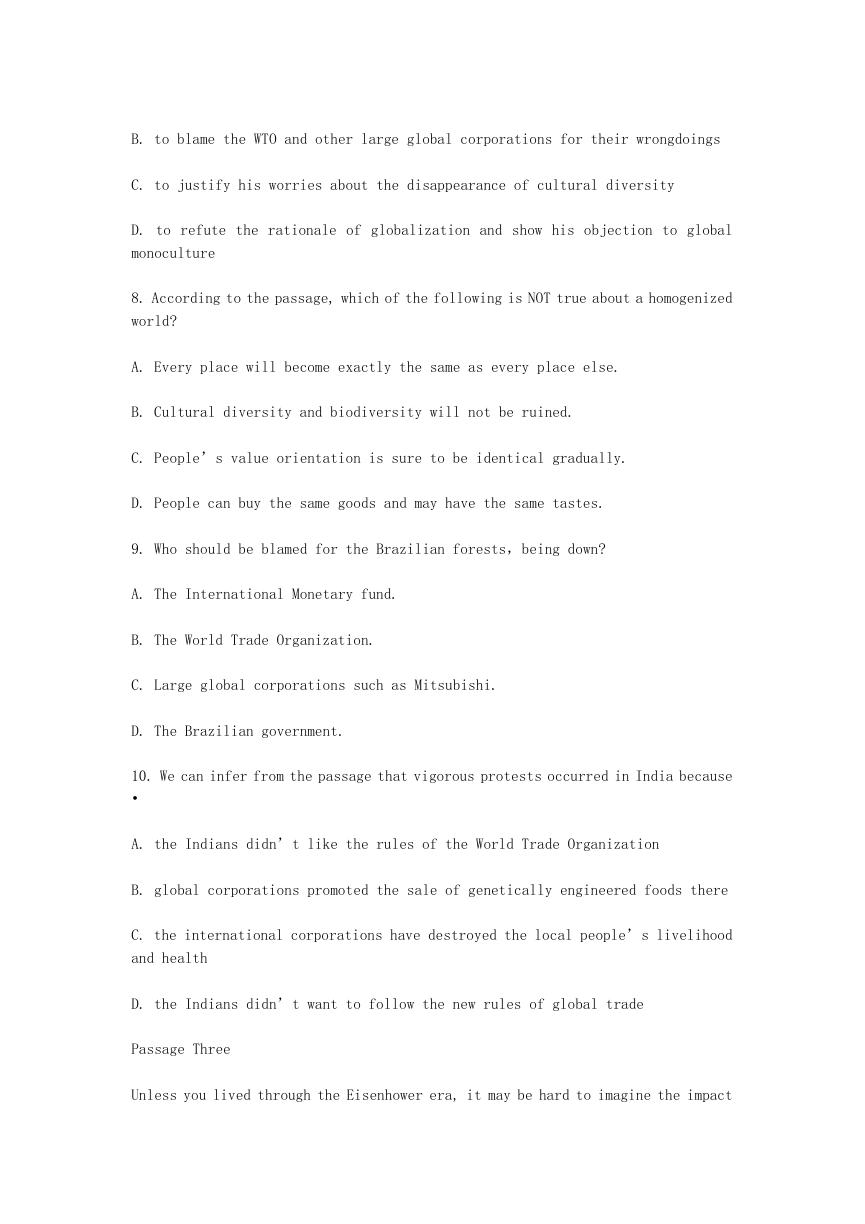

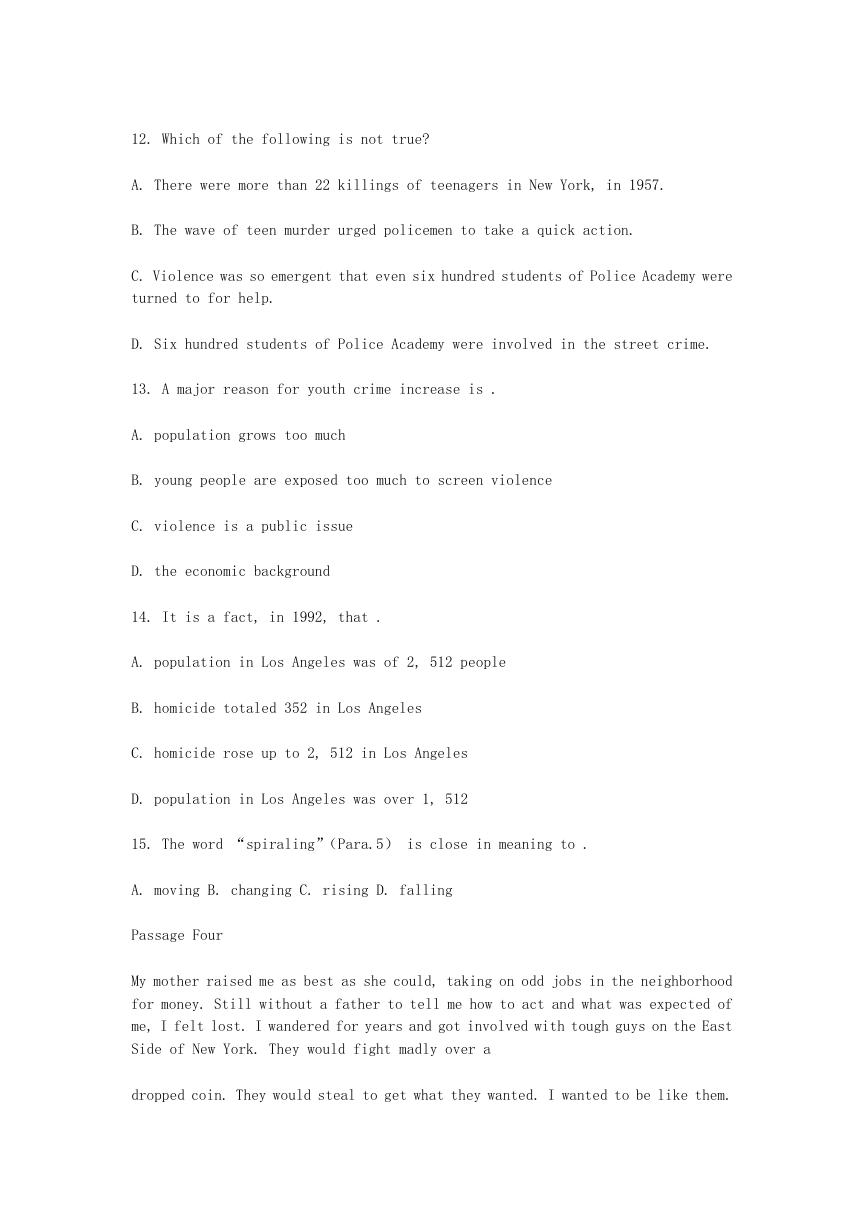








 2023年江西萍乡中考道德与法治真题及答案.doc
2023年江西萍乡中考道德与法治真题及答案.doc 2012年重庆南川中考生物真题及答案.doc
2012年重庆南川中考生物真题及答案.doc 2013年江西师范大学地理学综合及文艺理论基础考研真题.doc
2013年江西师范大学地理学综合及文艺理论基础考研真题.doc 2020年四川甘孜小升初语文真题及答案I卷.doc
2020年四川甘孜小升初语文真题及答案I卷.doc 2020年注册岩土工程师专业基础考试真题及答案.doc
2020年注册岩土工程师专业基础考试真题及答案.doc 2023-2024学年福建省厦门市九年级上学期数学月考试题及答案.doc
2023-2024学年福建省厦门市九年级上学期数学月考试题及答案.doc 2021-2022学年辽宁省沈阳市大东区九年级上学期语文期末试题及答案.doc
2021-2022学年辽宁省沈阳市大东区九年级上学期语文期末试题及答案.doc 2022-2023学年北京东城区初三第一学期物理期末试卷及答案.doc
2022-2023学年北京东城区初三第一学期物理期末试卷及答案.doc 2018上半年江西教师资格初中地理学科知识与教学能力真题及答案.doc
2018上半年江西教师资格初中地理学科知识与教学能力真题及答案.doc 2012年河北国家公务员申论考试真题及答案-省级.doc
2012年河北国家公务员申论考试真题及答案-省级.doc 2020-2021学年江苏省扬州市江都区邵樊片九年级上学期数学第一次质量检测试题及答案.doc
2020-2021学年江苏省扬州市江都区邵樊片九年级上学期数学第一次质量检测试题及答案.doc 2022下半年黑龙江教师资格证中学综合素质真题及答案.doc
2022下半年黑龙江教师资格证中学综合素质真题及答案.doc